Newsletters
- Home
- Publications
- Newsletter Archive
- Newsletter
May/June 2016
Inside This Issue:
- Research Examines Financial Fitness of Volunteer Fire Companies
- Center Releases 2017 RFP
- Chairman's Message
- Center Sponsors Third Round of Public Hearings on Heroin/Opioid Epidemic
- Rural Snapshot: High School Graduation Rates
- Hotel and Motel Trends Across the State and Nation
- Just the Facts: Rural Bankruptcies
Research Examines Financial Fitness of Volunteer Fire Companies
Volunteer fire companies have a strong history in Pennsylvania but have been challenged by a decrease in volunteers and a range of financial constraints over the past 30 years.
To better understand the financial condition of Pennsylvania’s volunteer fire companies (VFCs), Dr. Melanie Anderson of Slippery Rock University examined rural and urban VFCs statewide to analyze trends in revenue, expenditures, operating budgets, capital budgets, cash reserves, and long-term savings.
The research, sponsored by the Center for Rural Pennsylvania, used data from the Pennsylvania Department of Community and Economic Development, the Governor’s Center for Local Government Services, Internal Revenue Service (IRS) 990 Forms, and Guidestar for the 5-year period of 2008 to 2012.
According to the research, in 2012, urban municipalities spent a median of $117,030 on fire protection, and rural municipalities spent a median of $17,091 on fire protection.
Among urban municipalities, townships of the first class spent the most on fire protection (median of $391,869 or 2.98 percent of total budgets) in 2012, followed by cities (median of $340,659 or 3.22 percent of total budgets), townships of the second class (median of $228,558 or 4.40 percent of total budgets) and boroughs (median of $50,051 or 2.38 percent of total budgets).
Per capita spending for these municipalities in 2012 was: $27.28 for townships of the first class, $30.20 for cities, $23.19 for townships of the second class, and $16.58 for boroughs.
Rural municipalities spent less on fire protection in both total dollars and per capita when compared to urban municipalities, but spent larger percentages of their budgets on fire protection.
The research also found that municipal financial support of VFCs decreased from 2008 to 2012, except among townships of the second class. Capital budgets for all VFCs also decreased over the 5-year study period. All of these factors point to difficult financial situations for VFCs.
Based on the study results, the researcher provided several considerations for state agencies, municipalities and VFCs that may help VFCs improve or maintain their financial strength. For example, state agencies may provide VFCs with more education about service revenue billing; municipalities may provide more support for service billing or via third parties; and VFCs could work more closely with state and local officials to gather more information about fire taxes and other sources of revenue for capital purchases. The researcher also suggests that the state provide incentives for VFCs to report call data, and to develop a database of VFCs in Pennsylvania, which would include information on merged/consolidated VFCs in Pennsylvania. State agencies could also provide grant writing assistance and instruction to small rural VFCs with with operating budgets of less than $150,000, since they did not receive as much grant monies as other VFCs.
For a copy of the research report, The Financial Fitness of Pennsylvania Volunteer Fire Companies, visit the Center’s website at www.rural.palegislature.us
Center Releases 2017 RFP
The Center has released its 2017 Request for Proposals (RFP) and is accepting applications for its Research Grant Program.
Eligible applicants for the program are qualified faculty members of Pennsylvania State University, the Pennsylvania State System of Higher Education universities and the regional campuses of the University of Pittsburgh.
All applicants must first submit a Letter of Intent, which is due May 23.
For more information on the RFP and the Center’s Research Grant Program, visit www.rural.palegislature.us/grants_rfp.html.
Chairman's Message
When it was created in 1987, the Center for Rural Pennsylvania was charged with promoting and sustaining the vitality of Pennsylvania's rural and small communities. While that mission may seem expansive, it actually allows the Center to address the wide range of issues that impact our rural communities.
Take, for example, our most recent research on the financial fitness of volunteer fire companies, which is featured on Page 1. Like many other communities across the state and nation, rural communities have relied on their volunteer fire companies for generations. Over the years, many of these companies have seen their active volunteer bases shrink as their efforts to raise necessary funding have expanded. This research looked at both rural and urban volunteer fire companies to understand and uncover trends in revenues, expenditures, operating budgets, capital budgets and more. It provides an important look at the financial health of volunteer fire companies and offers several considerations on how state and local government agencies, as well as volunteer fire companies themselves, can maintain financial health. The report is available on the Center’s website.
With the release of its 2017 Request for Proposals, or RFP, also featured on Page 1, the Center is looking to examine a variety of other important topics through its Research Grant Program.
Topics for the 2017 RFP include an analysis of emergency medical services personnel, the economic impact of hunting and fishing in Pennsylvania, employment opportunities for rural residents with disabilities, and the availability of medication-assisted treatment for opioid addiction in rural and urban Pennsylvania.
The research topic on medication-assisted treatment was developed after hearing testimony on this treatment at several public hearings on heroin and opioid addiction sponsored by the Center. Over the past 3 years, the Center has been making its way around the state to gather information and insights on the heroin and opioid epidemic that has been plaguing our state and our nation. It’s a topic that the Center never imagined to consider or confront, but one that our mission and mandate certainly compelled us to address.
Over the next several months, the Center will conduct other public hearings on this epidemic, as our board and staff are committed to uncovering more ways in which our commonwealth can address this crisis.
Thank you to all who have supported the Center at these hearings €“ participants, panelists, facility hosts and attendees €“ and thank you to those who continue to offer their support in addressing this critical issue.
Senator Gene Yaw
Center Sponsors Third Round of Public Hearings on Heroin/Opioid Epidemic
More than 160 people attended two public hearings on the heroin/opioid epidemic sponsored by the Center for Rural Pennsylvania on April 1 and April 21.
In this third round of hearings held by the Center over the past 3 years, law enforcement, treatment and health care professionals, and local government officials talked about the ways in which they and their organizations are confronting this epidemic.
The April 1 hearing was held at the University of Pittsburgh-Bradford and was hosted by Center Board Member and Pitt-Bradford President Dr. Livingston Alexander.
The April 21 hearing was held at Geisinger-Lewistown Hospital and was hosted by Sen. Jake Corman.
A third hearing is scheduled for June 2 in Aliquippa.
More details about the hearings are on the Center’s website at www.rural.palegislature.us.
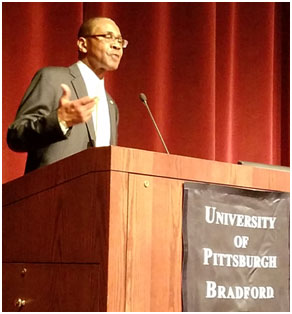
Dr. Livingston Alexander, president of the University of Pittsburgh-Bradford and Center board member,
welcomed more than 100 attendees to the April 1 public hearing on heroin at Pitt-Bradford.
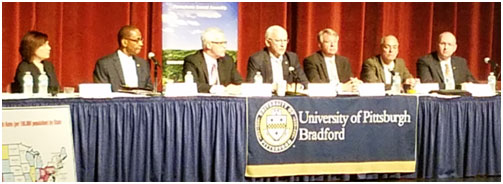
Panelists at the Pitt-Bradford hearing were (l to r) Dr. Nancy Falvo, Center board secretary; Dr. Alexander; Barry Denk, Center director; Sen. Gene Yaw,
Center board chairman; Sen. John Wozniak, Center board vice chairman; Rep. Garth Everett, Center board treasurer; and Rep. Martin Causer.
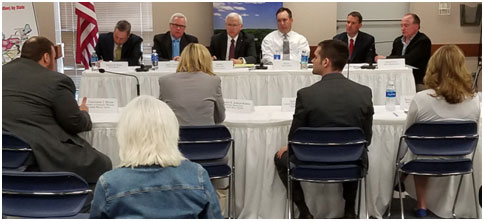
Panelists at the Lewistown hearing were (l to r): Steve Brame, Center board member; Barry Denk; Sen. Yaw;
Sen. Jake Corman; Rep. Adam Harris; and Rep. Kerry Benninghoff.
Rural Snapshot: High School Graduation Rates
Background on the Data
The Pennsylvania Department of Education compiles graduation rates data for Pennsylvania public schools. Pennsylvania's public high schools provide the graduate and enrollment data through the Pennsylvania Information Management System (PIMS), which is used to calculate graduation rates.
The graduation rates, grouped into 4-year, 5-year and 6-year cohorts, are a calculation of the percentage of students who have graduated with a regular high school diploma within a designated number of years since the student first entered high school. The rate is determined for a group of students who have all entered high school for the first time during the same school year. Unless otherwise noted, the data used here are from the 4-year graduation cohort. All data are from the Pennsylvania Department of Education unless noted otherwise.
Graduation Rates by School District, 2013-14
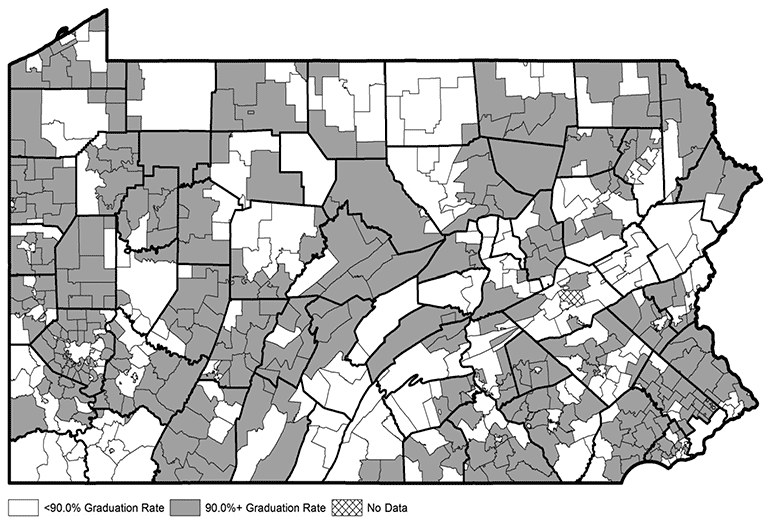
High School Graduation Rates by Student Type, 2013-14
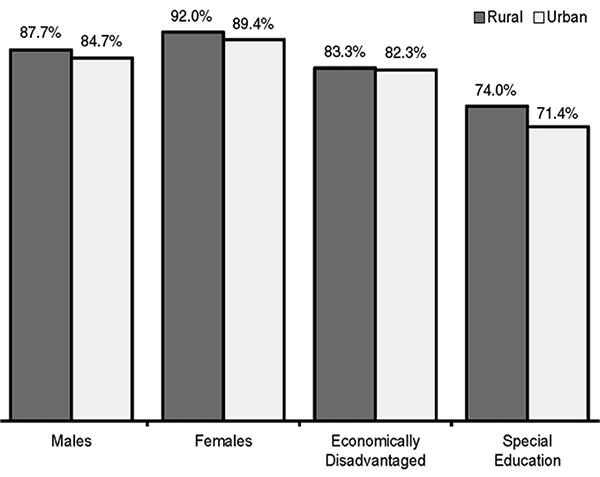
Graduation Rates in Pennsylvania's Rural and Urban Public Schools, 2010-11 to 2013-14
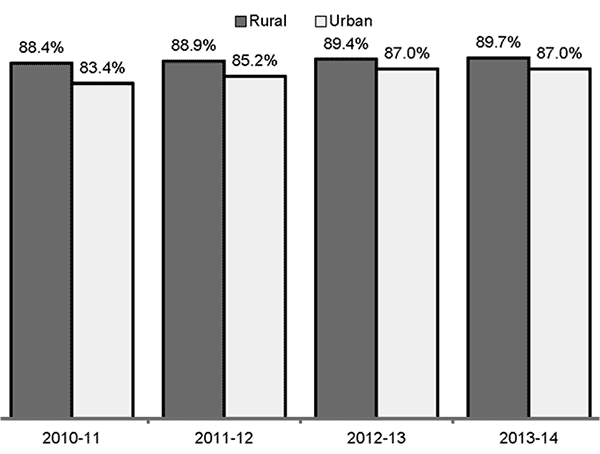
Percent of High School Seniors Planning to Attend a Postsecondary Institution after Graduation, 2009-10 to 2013-14
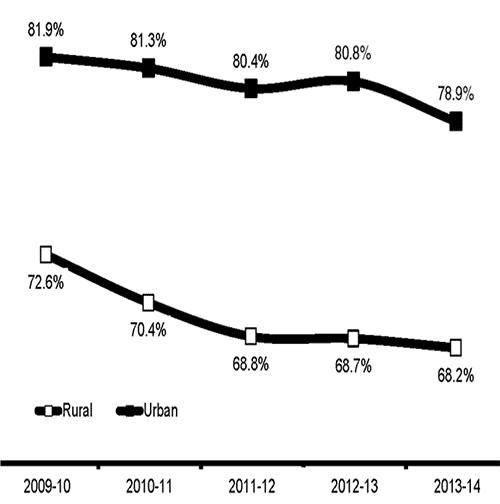
Includes only those school districts that reported data for each year from 2009-10 to 2013-14.
High School Dropout Rates by State: Percent of Young Adults (18-34) Not Enrolled in School and No High School Diploma or GED, 2014
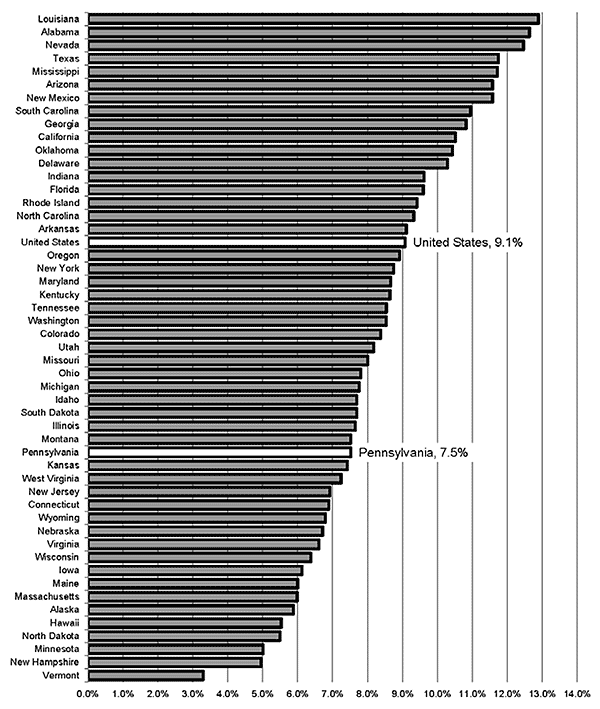
Data source: 2014 American Community Survey, Public Use Microdata Sample, U.S. Census Bureau.
Facts
In 2014, 33 percent of rural 11th and 12th graders and 45 percent of urban 11th and 12th graders lived in a home where one or more adults had a bachelor's degree or higher.
In 2014, 8 percent of rural and 7 percent of urban young adults (18-34) were high school drop outs (not enrolled in school and did not have a high school diploma or GED).
Hotel and Motel Trends Across the State and Nation
An estimated 189 million travelers came to Pennsylvania in 2013, with 65 million staying overnight, according to data from the Pennsylvania Office of Travel and Tourism.
Travelers in rural Pennsylvania had a choice of 534 hotels and motels, according to second quarter 2015 data from the Pennsylvania Department of Labor and Industry.
From 2005 to 2015, the number of hotels and motels increased in rural Pennsylvania by 8 percent.
For travelers in urban Pennsylvania, the choice of hotels and motels was a bit more expansive, with 909 hotels and motels from which to choose.
From 2005 to 2015, the number of urban hotels and motels increased 15 percent.
From 2005 to 2014, the number of hotels and motels across the U.S. increased 6 percent, according to the U.S. Census Bureau’s County Business Patterns. The largest increases in hotel/motel accommodations were in North Dakota, Oklahoma, and Texas, each with increases of 30 percent or more.
Seventeen states saw decreases in the number of hotels and motels. The steepest declines were in Nevada, Maine, and Vermont, with a 7 percent or more decline.
Among all the states, Pennsylvania had the 17th highest increase (7 percent) in the number of hotels and motels.
56 percent of all hotels and motels in rural Pennsylvania and 59 percent of all hotels and motels in urban Pennsylvania are within 2 miles of an interstate highway or Turnpike exit.
Number of Hotels and Motels in Pennsylvania, 2nd Quarter 2015
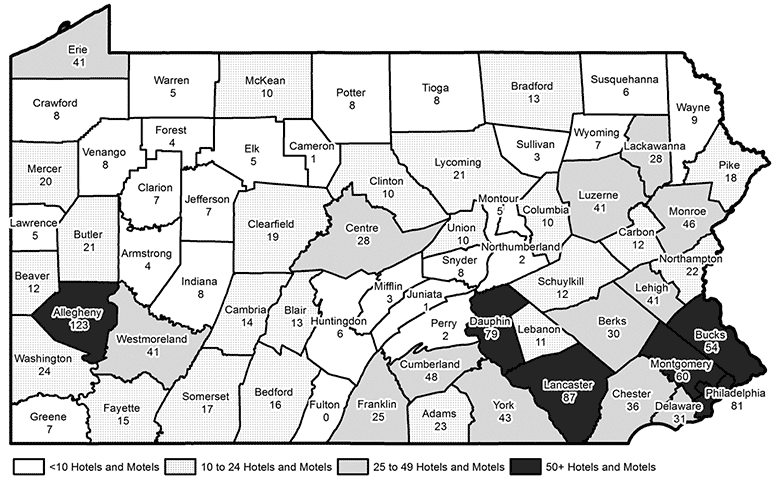
Data source: Pennsylvania Bureau of Labor and Industry. Map by the Center for Rural Pennsylvania.
Just the Facts: Rural Bankruptcies
Rural bankruptcy filings are on the decline, according to data from the Administrative Office of the U.S. Courts. Data show that, from 2014 to 2015, there was a 2 percent decline in bankruptcy filings among rural Pennsylvania businesses and individuals. The data encompass a 12-month period ending in 2014 and a similar period ending in 2015.
The decline in rural bankruptcies, however, pales in comparison to the decline in urban bankruptcies, as the number of urban businesses and individuals filing for bankruptcy declined 15 percent from 2014 to 2015. Nationwide, there was a 12 percent decline in filings.
In 2015, there were 6,536 rural bankruptcy filings, or 1.9 filings per 1,000 residents. During the same period, there were 16,792 urban bankruptcy filings, or 1.8 per 1,000 residents.
The majority of both rural and urban bankruptcy filings were consumer, or nonbusiness, filings (97 and 96 percent, respectively). Consumer debt is debt incurred by an individual primarily for a personal, family, or household purpose. If the debtor is a corporation or partnership, or if the debt related to the operation of a business predominates, the debt is considered to be business.
While business bankruptcy filings are only a fraction of the total filings (less than 5 percent), they have increased. From 2014 to 2015, there was a 6 percent increase in rural business filings. Urban business filings, however, decreased 25 percent.
Within Pennsylvania, all but 15 of the state’s 67 counties had a decline in bankruptcy filings. Among these counties, the top three were Cameron, Somerset, and Blair. In each, the number of filings doubled. Per capita, the three counties with the highest number of bankruptcies were Pike, Monroe, and Somerset, each with 4.0 or more filings per 1,000 residents.
Nationwide, every state had a decline in bankruptcy filings. The three states with the largest declines were California, Wyoming, and Colorado, each with a decline of 22 percent or more. Pennsylvania had the nation’s 23rd largest decline in bankruptcies at 12 percent. Per capita, the three states with the highest number of bankruptcies were Tennessee, Georgia, and Alabama, each with 5.0 or more filings per 1,000 residents. Pennsylvania had the nation’s 33rd highest bankruptcy rate with 1.8 per 1,000 residents.
